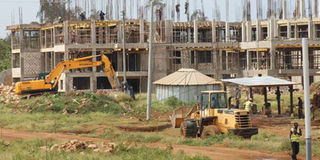New Utalii college and Bomas projects avenue for corruption

Construction work goes on on the 42 acre piece of land for the Ronald Ngala Utalii College in in Vipingo, Kilifi County on August 25, 2015. PHOTO | WACHIRA MWANGI | NATION MEDIA GROUP
What you need to know:
- The Public Investments Committee is investigating how the ministry came to spend nearly Sh3 billion on a project despite the fact that the work done suggests that it is still a long way from completion.
- The Ronald Ngala Utalii College project is another example of how grandly designed infrastructure projects pose high corruption risks.
- To unravel the games of deception around the Ronald Ngala project, the Public Investments Committee must dig deep and insist on putting the architects and consultants to task.
- Well-connected architects are then invited to prepare designs which are presented before hurriedly convened board meetings.
So, what happened to the principle of collective responsibility by members of the Cabinet? In theory, decisions freely arrived at by the Cabinet should be loyally supported as the decisions of the whole government.
Away from the limelight, two Cabinet secretaries are pulling in different directions over how to respond to the queries of a parliamentary committee investigating a major corruption case involving the construction of the multi-billion shilling Ronald Ngala Utalii College in Kilifi.
From what I gather, Tourism Cabinet Secretary Najib Balala recently fired off an angry letter to his counterpart for East African Community and Labour, Ms Phyllis Kandie, accusing her of trying to blame him for the scam and ignoring the fact that he left the ministry long before the procurement of consultants and contractors for the project had started.
Apparently, Ms Kandie had on May 24 written a letter to the clerk of the Public Investments Committee in which she not only absolved herself of blame over the matter under investigations, but heaped the blame on Mr Balala. The project is under both the Ministry of Tourism and the Kenya Tourism Fund — formerly known as Catering and Tourism Development Levy Trustees.
Mr Balala’s point is that he cannot be made to bear responsibility for the corruption allegations surrounding the project because he left the ministry on March 26, 2012, while serving under the Grand Coalition government when not a single procurement or payment had been made on the project.
Controversy has dogged the project right from the beginning. In its early stages, Coast politician Joe Khamisi abruptly resigned from the chairmanship of the board of an entity known as Ronald Ngala Utalii College that was supposed to implement the project after it came to light that this body had been incorporated irregularly — by a mere ministerial decree instead of an Act of Parliament, like other parastatals.
In December, 2013, the National Treasury wrote to Ms Kandie, pointing out that the Ministry of Tourism had awarded the contract for the project at Sh8.9 billion despite the fact that the Cabinet had only approved Sh1.9 billion.
The Treasury’s concerns were ignored. It is also understood that during a Cabinet retreat in Nanyuki in February 2014, President Uhuru Kenyatta directed the Ministry of Tourism to discontinue both this project and the plans the ministry had to undertake another grandly designed project — a multi-billion property development one at the Bomas of Kenya. However, work on the project continued, the only change being that the scope and budget were arbitrarily reduced to Sh4.7 billion.
The Public Investments Committee is investigating how the ministry came to spend nearly Sh3 billion on a project despite the fact that the work done suggests that it is still a long way from completion.
There are important lessons. The Ronald Ngala Utalii College project is another example of how grandly designed infrastructure projects pose high corruption risks.
Influence is usually brought to bear, especially at the design stages where unscrupulous architects will be brought in to alter and make the scope and components of the project unnecessarily complex to increase the potential for corrupt earnings.
To unravel the games of deception around the Ronald Ngala project, the Public Investments Committee must dig deep and insist on putting the architects and consultants to task.
The games and schemes are all too familiar. A newly appointed Cabinet secretary or CEO of a public corporation looking for a project from which to create kick-back opportunities will come up with some grand and lofty project — a plan to build corporate headquarters or a staff training school, for example.
Well-connected architects are then invited to prepare designs which are presented before hurriedly convened board meetings. Within months, approval will have been received, with the chief executive given the go-ahead to contract a builder. It does not matter whether there is a budget or funds for the project.
In the initial stages, the plan was that the hotel component of the Ronald Ngala Utalii College be built under a private-public partnership arrangement.
However, the architects decided to design the whole project, including even components that were supposed to be built by the private sector.
This is how public institutions pay billions of shillings to architects and consultants for projects that are either abandoned or do not take off at all.
The Ronald Ngala Utalii project is the scam of a conspiracy between public officials and cowboy architects and consultants.





